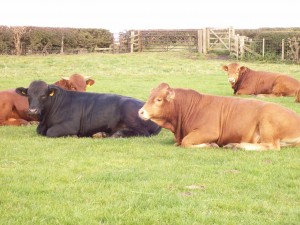Down on the Farm – May & June
Down on the Farm – May & June 2018
After what seemed like an endless winter and poor start to spring, the hot weather at the end of April and now into May has got everything moving again. Suddenly it seems as if al the crops have decided it’s safe to get into a growth spurt, so that’s where things have been busy recently.
Our silage fields have received their latest application of nitrogen fertilizer to make sure there are enough nutrients available to take advantage of the good growing conditions. At some point in the next few weeks they will be rolled with a heavy steel roller to press any stones down into the soil so that they don’t get picked up by the mower. The natural heave of the ground during the winter frosts etc causes rocks to move gradually up through the soil until they poke out the top. As we mow very close to the ground to maximise yield, any rocks sticking up can cause some serious damage to machinery – best avoided if you don’t want big bills for replacing blades. Rolling also helps flatten the ground generally so that when we mow close to the surface we don’t scalp any high spots and end up with soil contamination in the silage – the bacteria in the soil can cause spoilage.
Although we do spread a fair bit of farmyard manure from the cattle on the fields, the arable crops have also had their allocation of fertilizer – their requirements are a bit more complex than the grass so they have a blended fertilizer with various nutrients to keep things balanced. This makes sure we have a healthy crop which is able to withstand diseases and pests better and also grows fast enough to keep any weeds back. Timing of the application is important – it needs to be available when the growth spurts are happening. The temperature and moisture of the soil also plays a part – if things are too dry the nutrients from the fertilizer just don’t get drawn into the soil. We also have some more spraying to complete on the winter crops to control weeds and pests. If we don’t catch these at the right time they can have a big effect on eventual yields at harvest. The oilseed rape crop has come into flower well – the distinctive yellow flowers really stand out. So far it looks like the oilseed has survived the winter well and will set plenty of seed. The tiny black seeds it produces will go away for crushing to extract the oil. This goes into many different things – cosmetics for example. Some crops are grown especially for oil for cooking – these are specialised varieties which are harder to grow. The team at Yellow Fields near Morpeth grow these to produce the rapeseed oil we stock in the farm shop.
A large number of the cattle have been turned out again now the grass has started to grow more quickly. It’s been a later start to the grazing season than normal as it’s only recently that the fields have been in the right conditions. The normal rodeo ensues as soon as they get out of the sheds – they seem determined to check out every corner of the pasture at a full gallop so it’s best to stand back and let them get on with it. The rest of the cattle will all be out in the next two weeks and then the empty sheds will then be mucked out and the manure stacked to compost down a bit until we spread it after harvest.
We will also need to start thinking about getting sheep sheared – generally this starts in June, but if the weather remains hot then we might need to bring this forward. The lambs are growing well now the grass has started to grow – they are already nibbling away at the fresh stuff although they are still feeding from the ewes. Pigs being pigs, they generally cause us little problem as long as they get well fed and have plenty of straw to rummage and sleep in. When it gets hot they also take great pleasure in getting as dirty and wet as possible before coming back into the nice fresh clean straw we have just put into their sleeping areas – and they don’t even wipe their feet.



